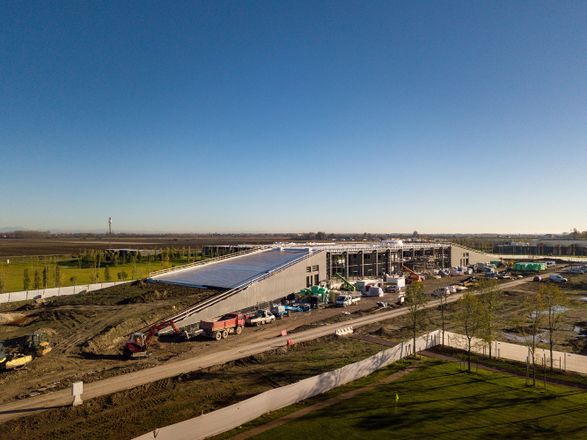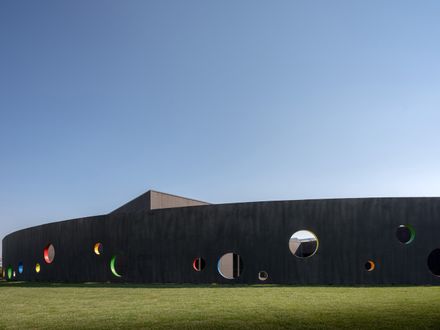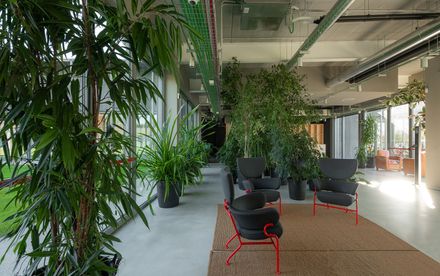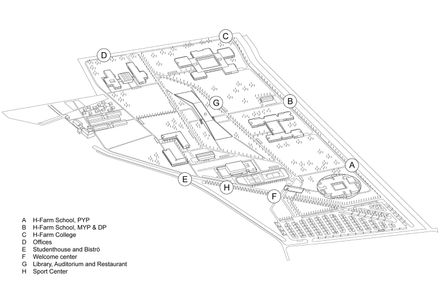
H-FARM Campus
YEAR
2020
MANUFACTURERS
Isoplam, Schuco
GROUP LEADER
Mariano Zanon
PARTNERS
Alessio Bolgan, Bruno Ferretti
INFRASTRUCTURES
Sinergo S.p.A.
LOCATION
Italy
ARCHITECTS TEAM
Marco Barbato, Matteo Barzi, Erika Bettin, Sara Bocus, Cristina Cappellari, Elisa Ioime, Federico Munaretto, Davide Rachello, Matteo Scarioli, Cecilia Salmaso, Nicola Strametto, Matteo Tomasi, Maddalena Vedana
BIM
DVA DVisionArchitecture
CATEGORY
Mixed Use Architecture, Educational Architecture
Text description provided by architect.
H-FARM CAMPUS is an ambitious project: a high education Campus in the countryside of Treviso, set in an isolated but at the same time international location thanks to its proximity to Venice airport.
The challenge launched by H-FARM involves the construction of buildings for education and services in a 30 ha area along the river Sile, close to H-FARM headquarters, the promoting company, with the aim of training young people and children by merging the international school system and the use of technologies at the service of learning.
The complex accommodates children from kindergarten to university and offers services such as a welcome center, a student house, a greenhouse for food service, a gymnasium with sports fields, and a large central community building with a library and meeting spaces.
The new intervention is in continuity with the existing core, using volumes partly obtained from the demolition of buildings not relevant from a historical-architectural point of view (including some buildings for military use), with the aim of proposing a "zero-cube" intervention.
The buildings are developed on a maximum of two floors respecting the geometry of the context and preventing the raising of physical barriers that interrupt the overall vision of the surrounding countryside, experimenting with the principles of new rurality. The large windows, patios, canopies, and internal courtyards are places from which to admire nature and be immersed in the surrounding landscape: architecture leaves room for vegetation.
The open space also becomes an educational place in order to stimulate the new generations to knowledge and respect the territory: the landscape has guided architecture and technical choices, not vice versa.
The masterplan involves the construction of eight buildings, in addition to some service volumes. The access point to the campus is through the reception (F), a one-storey volume characterized by a projecting pitched roof, located just beyond the intersection between the renewed route of Via Annia (historical archaeology of the place) and the paths coming from the public parking.
Within the belt placed between the central ring and the secondary one, located further north, are three of the school buildings: one building dedicated to elementary school (A), one to secondary education (B), one to university-level courses (C).
At the meeting point between the inner and outer ring, near the western border of the area, in addition to the existing nucleus of H-FARM, there is a complex consisting of two buildings for office use (D).
On one hand, it is a natural continuation of the training path, on the other hand, it is a bridge towards a business reality, such as H-FARM, based on continuous innovation in the application of knowledge with the “conscious” use of new technologies.
Continuing eastward, separated by another green area, we meet the student residence (E), composed of two buildings for students' accommodation and a building hosting dining services and common laundry. A little further on, the circle closes with the sports facilities (H), indoors and outdoors.
At the center of this ring, a multipurpose building (G) designed with RSHP – Rogers Stirk Harbour + Partners: a reference point for major collective activities such as conferences, library, food, leisure time, the building becomes a panoramic bridge from which to observe the entire campus and a physical link between its parts.


































